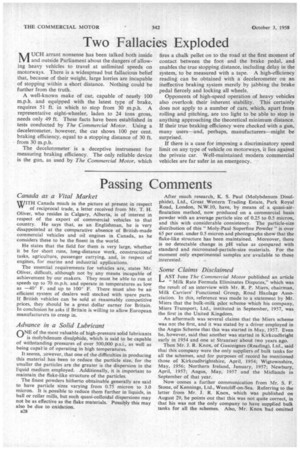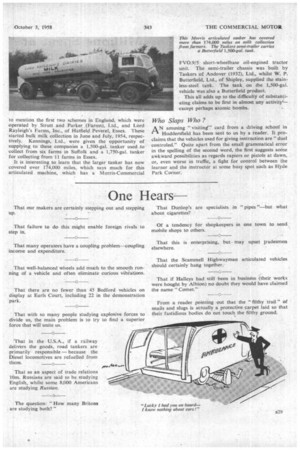Passing Comments
Page 62

Page 63

If you've noticed an error in this article please click here to report it so we can fix it.
Canada as a Vital Market
WITH Canada much in the picture at present in respect of reciprocal trade, a letter received from Mr. T. H. Oliver, who resides in Calgary, Alberta, is of interest in respect of the export of commercial vehicles to that country. He says that, as an Englishman, he is very disappointed at the comparative absence of British-made commercial vehicles and oil engines in Canada, as he considers these to be the finest in the world.
He states that the field for them is very large, whether it be for short runs, long-distance work, constructional tasks, agriculture, passenger carrying, and, in respect of engines, for marine and industrial applications.
The essential requirements for vehicles are, states Mr. Oliver, difficult, although not by any means incapable of achievement by our makers. They must be able to run at speeds up to 70 m.p.h. and operate in temperatures as low as —40° F. and up to 100° F. There must also be an efficient system of dealers well stocked with spare parts. If British vehicles can be sold at reasonably competitive prices, they should be a great dollar earner for Britain. In conclusion he asks if Britain is willing to allow European manufacturers to creep in.
Advance in a Solid Lubricant
riNE of the most valuable of high-pressure solid lubricants is Molybdenum disulphide, which is said to be capable of withstanding pressures of over 500,000 p.s.i., as well as being capatle of operating in high temperatures.
It seems, .lowever, that one of the difficulties in producing this material has been to reduce the particle size, for the smaller the particles are the greater is the dispersion in the liquid medium employed. Additionally, it is important to maintain the flake-like structure of the particles.
The finest powders hitherto obtainable generally are said to have particle sizes varying from 0.75 micron to 3.0 micron. It is possible to reduce them further in liquids, in ball or roller mills, but such quasi-colloidal dispersions may not be as effective as the flake materials. Possibly this may also be due to oxidation.
a28 After much research, K. S. Paul (Molybdenum Disulphide), Ltd., Great Western Trading Estate, Park Royal Road, London, N.W.10, have, by means of a quasi-airfloatation method, now produced on a commercial basis powder with an average particle size of 0.25 to 0.5 micron, and this with considerable consistency. The particle-size distribution of this " Moly-Paul Superfine Powder" is over 65 per cent. under 0.5 micron and photographs show that the flake-like structure has been maintained. Moreover, there is no detectable change in pH value as compared with standard and micronated-particle-size materials. For the moment only experimental samples are available to those .interested.
Some Claims Disclaimed
AST June The Commercial Motor published an article "Milk Rate Formula Eliminates Disputes," which was the result of an interview with Mr. R. P. Miers, chairman, Milk Carriers' Functional Group, Road Haulage Association. In this, reference was made to a statement by Mr. Miers that the bulk-milk pilot scheme which his company, Miers Transport, Ltd., instituted in September, 1957, was the first in the United Kingdom.
An aftermath was several claims that the Miers scheme was not the first, and it was stated by a driver employed in the Angus Scheme that this was started in May, 1957. Even he, however, said that another was started in Kirkcudbright early in 1954 and one at Stranraer about two years ago.
Then Mr. J. R. Knox, of Gascoignes (Reading), Ltd., said that this company were the only suppliers of bulk tanks for all the schemes, and for purposes of record he mentioned those of Kirkcudbrightshire, April, 1954; Wigtownshire, May, 1956; Northern Ireland, January, 1957; Newbury, April, 1957; Angus, May, 1957 and the Midlands in September of that year.
Now comes a further communication from Mr. S. F. Stone, of Kennings, Ltd., Westcliff-on-Sea. Referring to the letter from Mr. J. R. Knox, which was published on August 29, he points out that this was not quite correct, in that his was not the only company to have supplied bulk tanks for all the schemes. Also, Mr. Knox had omitted
to mention the first two schemes in England, which were operated by Strutt and Parker .(Farms), Ltd, and Lord Rayleigh's Farms, Inc., of Hatfield Peverel, Essex. These started bulk milk collection in June and July, 1954, respectively. Kennings, Ltd., were given the opportunity of supplying to these companies a 1,500-gal. tanker used to collect from six farms in Suffolk and a 1,750-gal. tanker for collecting from 11 farms in Essex.
It is interesting to learn that the larger tanker has now covered over 174,000 miles, which says much for this articulated machine, which has a Morris-Commercial FV0.9/5 short-wheelbase oil-engined tractor unit. The semi-trailer chassis was built by Taskers of Andover (1932), Ltd., whilst W. P. Butterfield, Ltd., of Shipley, supplied the stainless-steel tank. The tank on the 1,500-gal. vehicle was also a Butterfield product.
This all adds up to the difficulty of substantiating claims to be first in almost any activity— except perhaps atomic bombs.
Who Slaps Who ?
A N amusing " visitint" card from a driving school in
Huddersfield has been sent to us by a reader. It proclaims that the vehicles used for giving instruction are "duel controled." Quite apart from the small grammatical error in the spelling of the second word, the first suggests some awkward possibilities as regards rapiers or pistols at dawn, or, even worse in traffic, a fight for control between the learner and the instructor at some busy spot such as Hyde Park Corner.
















































































































































































